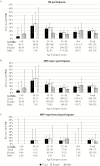Prevalence of Pre-antiretroviral-Treatment Drug Resistance by Gender, Age, and Other Factors in HIV-Infected Individuals Initiating Therapy in Kenya, 2013-2014
- PMID: 29040633
- PMCID: PMC5853791
- DOI: 10.1093/infdis/jix544
Prevalence of Pre-antiretroviral-Treatment Drug Resistance by Gender, Age, and Other Factors in HIV-Infected Individuals Initiating Therapy in Kenya, 2013-2014
Abstract
Background: Pre-antiretroviral-treatment drug resistance (PDR) is a predictor of human immunodeficiency virus (HIV) treatment failure. We determined PDR prevalence and correlates in a Kenyan cohort.
Methods: We conducted a cross-sectional analysis of antiretroviral (ARV) treatment-eligible HIV-infected participants. PDR was defined as ≥2% mutant frequency in a participant's HIV quasispecies at pol codons K103N, Y181C, G190A, M184 V, or K65R by oligonucleotide ligation assay and Illumina sequencing. PDR prevalence was calculated by demographics and codon, stratifying by prior ARV experience. Poisson regression was used to estimate prevalence ratios.
Results: PDR prevalences (95% confidence interval [CI]) in 815 ARV-naive adults, 136 ARV-experienced adults, and 36 predominantly ARV-naive children were 9.4% (7.5%-11.7%), 12.5% (7.5%-19.3%), and 2.8% (0.1%-14.5%), respectively. Median mutant frequency within an individual's HIV quasispecies was 67%. PDR prevalence in ARV-naive women 18-24 years old was 21.9% (9.3%-40.0%). Only age in females associated with PDR: A 5-year age decrease was associated with adjusted PDR prevalence ratio 1.20 (95% CI, 1.06-1.36; P = .004).
Conclusions: The high PDR prevalence may warrant resistance testing and/or alternative ARVs in high HIV prevalence settings, with attention to young women, likely to have recent infection and higher rates of resistance.
Clinical trials registration: NCT01898754.
Keywords: HIV; Pretreatment drug resistance; antiretroviral therapy; oligonucleotide ligation assay; transmitted drug resistance.
© The Author 2017. Published by Oxford University Press for the Infectious Diseases Society of America. All rights reserved. For permissions, e-mail: journals.permissions@oup.com.
Figures

References
-
- World Health Organization (WHO). Guideline on when to start antiretroviral therapy and on pre-exposure prophylaxis for HIV. Geneva, Switzerland: WHO, 2015. - PubMed
-
- Mutevedzi PC, Newell ML. Review: [corrected] The changing face of the HIV epidemic in sub-Saharan Africa. Trop Med Int Health 2014; 19:1015–28. - PubMed
-
- World Health Organization (WHO). Global action plan for HIV drug resistance 2016–2021. Geneva, Switzerland: WHO, 2016.
-
- Kuritzkes DR, Lalama CM, Ribaudo HJ et al. . Preexisting resistance to nonnucleoside reverse-transcriptase inhibitors predicts virologic failure of an efavirenz-based regimen in treatment-naive HIV-1-infected subjects. J Infect Dis 2008; 197:867–70. - PubMed
Publication types
MeSH terms
Substances
Associated data
Grants and funding
LinkOut - more resources
Full Text Sources
Other Literature Sources
Medical

